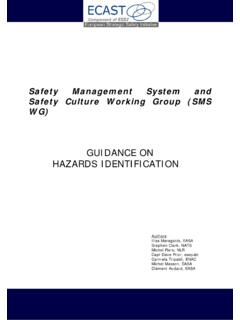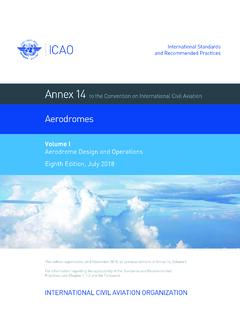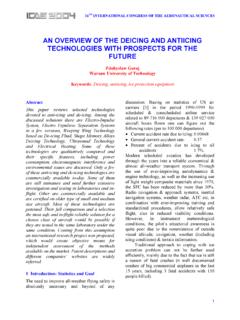Transcription of Aeronautical Decision Making - FAASafety.gov
1 Aeronautical Decision Making Note: This document has been adapted from pamphlet P-8470-69. Introduction FAA Advisory Circular 60-22 on Aeronautical Decision Making (FAA Advisory Circular 60-22) states that ADM. is a systematic approach to the mental process used by all involved in aviation to consistently determine the best course of action for a given set of circumstances. What does that really mean? From the moment your feet hit the floor in the morning until the key is safely back in your pocket at the end of each flight, you as the pilot (or crew member) have a never-ending series of decisions to make.
2 This process begins long before the master is switched on. The process of good ADM is a continuous flow of information in and actions out. This document describes an effective way to manage this information flow. Perceive, Process, Perform Perceive At any given moment, information affecting the outcome of a flight is all around you. How you manage that flow of information will definitely have an effect on the relative success or failure of each and every flight. First, gather information from all available sources. This is the perceive part of the process.
3 You might think of the information as situations or facts that require your attention. You will want to perceive situations or facts related to each major element of your flight: Pilot, passengers, and other people involved. Aircraft you will be flying. enVironment in which you will operate ( , airport, airspace, weather). External pressures likely to influence your Decision - Making process. Process The second part is to process the information that you perceived in step one. As you receive information, it is filtered through the five senses: sight, sound, smell, touch, and taste.
4 Not all information makes it through the system. You might not hear correctly, or some of the errors prevalent in human Decision Making might come into play (more below). In this step, however, the goal is to organize the information, interpret it, and try to match the alternatives with situations from your experience. To analyze in a structured way, process with CARE: Consequences of each hazard associated with the PAVE elements. Alternatives available. Reality of the situation or hazard. External pressures that might influence your analysis.
5 Perform Now it is time to act, which leads to the third part of the process: perform. How you act perform will be based on the perceiving and processing you did in the first two steps. At the most basic level, you perform in one of two ways: action or inaction. As you noticed in the perceive and process steps, there are a lot of external pressures on the human Decision - Making process. These influences may directly or indirectly affect the action or inaction you choose and also affect how quickly and decisively you perform. In addition, the action or inaction.
6 Aeronautical Decision Making comes from how accurately you perceived and processed the inputs up to this point in time. In the perform step, you need to do one of the following: Mitigate or Eliminate the hazard(s) and risk that you perceived and processed. Evaluate The relative success or failure of the flight maybe even the life-or-death moment may hinge on how well you have perceived, processed, and performed in the ADM process. There is one more important step in the model: evaluate. Constantly consider the outcome of every Decision that you make.
7 Question your judgment and your action (or inaction) at every step, and then start the 3-P process all over again. As with a good instrument scan in instrument meteorological conditions (IMC), the ADM process should not stop until your airplane is parked, shut down, and securely tied down. Human Factors At least in part, the act of perception relates to physical elements everything from your eyesight to the condition of the audio system in the rented airplane you are flying. The five senses of sight, sound, smell, touch, and taste are the conduits for 100 percent of the external information going to your brain.
8 These sensory filters are those circumstances that block some or all of that information from Making the journey from outside your head to inside your head. Perception ( , the act of acquiring information) is also affected by limitations of the human brain: Processing in the human brain is limited to about four bits of information per second. Working memory capacity is limited to about seven (plus or minus two) chunks, or pieces, of information at a time. However, our experience, education, and intuition give us the ability to fill in gaps in what we really obtained through the five senses.
9 For example, you may not have heard exactly every single word of the ground controller's taxi instructions, but your experience, training, intuition, and expectation help you fill in the missing words. Internal influences, such as motivation, attitude, emotion, distraction, and predisposition ( , expectation) also play a role in how your brain compensates for missing information. The problem, of course, is that you might fill in the gaps incorrectly and that, because the fill-in activity is so smooth and automatic, you may not even be aware that it has occurred.
10 Aeronautical Decision Making Pilot Error Going back to the previous example of the taxi instructions: suppose you are in a rented airplane with a scratchy radio and you have several passengers on board who are chatting among themselves. You are tired, but the airport is your home base, and you know the normal procedures like the back of your hand. You therefore know exactly what that taxi clearance from your parking spot to the active runway is likely to be. The bad radios and the noise from your passengers cause you to miss a few words of the ground controller's because your brain is expecting a certain sequence, it automatically fills in the missing words.
















